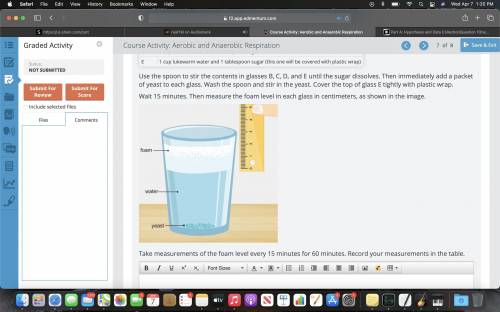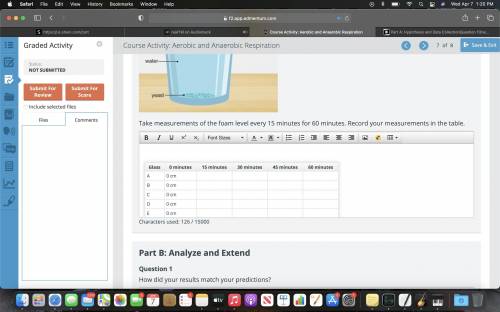Question 2
To prepare for the experiment, follow these steps:
Put one or two ice cubes...

Biology, 07.04.2021 23:30 journey888
Question 2
To prepare for the experiment, follow these steps:
Put one or two ice cubes in 1 cup of water. Chill the cup of water in the refrigerator for 1 to 2 hours. Remove any remaining ice when you take the water out of the refrigerator. This cup holds the ice-cold water.
Heat up three cups of water in the microwave for 15 to 20 seconds until they reach 100°F on the thermometer. If you heat the water too much, wait until the temperature drops to 100°F. These cups hold the lukewarm water.
Heat the last cup of water in the microwave until it reaches 212°F. This cup holds the boiling water.
Now line up the five glasses and label them A, B, C, D, and E. Then put the following contents in each glass:
Glass Contents
A 1 cup lukewarm water
B 1 cup lukewarm water and 1 tablespoon sugar
C 1 cup boiling water and 1 tablespoon sugar
D 1 cup ice-cold water and 1 tablespoon sugar
E 1 cup lukewarm water and 1 tablespoon sugar (this one will be covered with plastic wrap)
Use the spoon to stir the contents in glasses B, C, D, and E until the sugar dissolves. Then immediately add a packet of yeast to each glass. Wash the spoon and stir in the yeast. Cover the top of glass E tightly with plastic wrap.
Wait 15 minutes. Then measure the foam level in each glass in centimeters, as shown in the image.
Take measurements of the foam level every 15 minutes for 60 minutes. Record your measurements in the table.



Answers: 1
Another question on Biology

Biology, 21.06.2019 20:00
Microorganisms are involved in each of the following processes excepta. smog production.b. food production.c. infection.d. o2 production.e. decomposition of organic material.
Answers: 1

Biology, 22.06.2019 02:50
How does upwelling affect coastal fisheries? upwelling damages nutrient supplies at coastal fisheries as the warm, nutrient-rich surface water is replaced by nutrient-poor, cold water. upwelling damages nutrient supplies at coastal fisheries as the cold, nutrient-rich surface water is replaced by nutrient-poor, warm water. upwelling improves the nutrient supply at coastal fisheries as the warm, nutrient-rich surface water replaces the nutrient-poor, cold water. upwelling improves the nutrient supply at coastal fisheries as cold, nutrient-rich water replaces the warm, nutrient-poor surface water.
Answers: 3

Biology, 22.06.2019 06:00
In "the man in the water," what was the remarkable occurrence that rosenblatt reported?
Answers: 1

Biology, 22.06.2019 12:30
Gram-negative bacteria have a cell wall that is! and does not accept the stain, making itappear
Answers: 2
You know the right answer?
Questions

English, 30.11.2020 22:20

Mathematics, 30.11.2020 22:20

Computers and Technology, 30.11.2020 22:20


Social Studies, 30.11.2020 22:20


Mathematics, 30.11.2020 22:20

English, 30.11.2020 22:20





Computers and Technology, 30.11.2020 22:20






Mathematics, 30.11.2020 22:20



